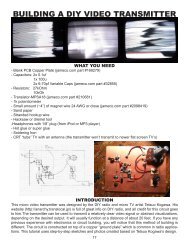Hacking a VGA Monitor to Bend Audio Into - Cracked Ray Tube
Hacking a VGA Monitor to Bend Audio Into - Cracked Ray Tube
Hacking a VGA Monitor to Bend Audio Into - Cracked Ray Tube
Create successful ePaper yourself
Turn your PDF publications into a flip-book with our unique Google optimized e-Paper software.
HACKING A <strong>VGA</strong> CRT TO BEND AUDIO<br />
INTO VIDEO<br />
WHAT YOU NEED<br />
-1 male <strong>VGA</strong> d-sub Connec<strong>to</strong>r 1<br />
-1 female <strong>VGA</strong> d-sub connec<strong>to</strong>r 2<br />
-<strong>Audio</strong> cables or jacks (1/4 inch, 1/8 inch, or RCA depending on your ideal output)<br />
-22-gauge single-strand wire (stranded makes it difficult)<br />
-Electrical tape and scissors<br />
-Soldering iron and solder<br />
-Wire strippers<br />
-<strong>VGA</strong> signal genera<strong>to</strong>r or computer with <strong>VGA</strong> output. (Sending unstable signals can damage computer hardware,<br />
so I highly recommend using a <strong>VGA</strong> signal genera<strong>to</strong>r. These are difficult <strong>to</strong> find, but it I have seen them for less than<br />
$20 on ebay.)<br />
-<strong>VGA</strong> CRT (tube) computer moni<strong>to</strong>r (LCD will not work)<br />
1 You could also use a male <strong>VGA</strong> breakout board, or cut in<strong>to</strong> a <strong>VGA</strong> cable itself, though wire-identification then becomes difficult<br />
2 You could also use a female <strong>VGA</strong> breakout board, or cut in<strong>to</strong> a <strong>VGA</strong> cable itself, though wire-identification then becomes difficult<br />
8
UNDERSTANDING A <strong>VGA</strong> CABLE<br />
A computer moni<strong>to</strong>r communicates through a Video<br />
Graphics Array (<strong>VGA</strong>) connec<strong>to</strong>r, which is organized<br />
in<strong>to</strong> a 15 pin (3 rows of 5) adapter at either end that<br />
sends discrete (and, therefore, hackable) RGBHV<br />
(RED, GREEN, BLUE, HORIZONTAL-SYNC, VERTI-<br />
CAL-SYNC) analog signals.<br />
The most useful part of its organization is that the RED,<br />
GREEN, and BLUE (R, G, B) colors of the moni<strong>to</strong>r are<br />
controlled by three discrete pins─pins 1-3. These are<br />
the pins the stereo audio signal gets sent <strong>to</strong>. Pin 13 is<br />
Horizontal-sync, which controls the frame rate and of<br />
the displayed image, and pin 14 is the Verical-sync,<br />
which displays the pixel information. Pin 5 is ground,<br />
and pins 6-10 are the ground connections for the R, G,<br />
B, H-SYNC, and V-SYNC.<br />
For this hack, wires need <strong>to</strong> be connection <strong>to</strong> pins 1 (R),<br />
2 (G), 3 (B), 5-10 (ground), 13 (horizontal-sync), and 14<br />
(vertical-sync)<br />
NOTE: D-sub connec<strong>to</strong>rs with soldering terminals are<br />
labeled with small numbers <strong>to</strong> ensure you’re soldering<br />
in<strong>to</strong> the correct holes (this can get VERY confusing, as<br />
female soldering terminals are the opposite of male, and<br />
on <strong>to</strong>p of that you’re seeing them in reverse). To save<br />
time and avoid having <strong>to</strong> resolder, be sure you’re placing<br />
the wire in<strong>to</strong> the correct terminal BEFORE applying<br />
any solder.<br />
male face<br />
female face<br />
R G B<br />
GRND<br />
V H<br />
H V<br />
B G R<br />
GRND<br />
9<br />
PIN 1: RED<br />
PIN 2: GREEN<br />
PIN 3: BLUE<br />
PIN 4: -<br />
PIN 5: GROUND<br />
PIN 6: RED GROUND<br />
PIN 7: GREEN GROUND<br />
PIN 8: BLUE GROUND<br />
PIN 9: -<br />
PIN 10: SYNC GROUND<br />
PIN 11: -<br />
PIN 12: -<br />
PIN 13: HORIZONTAL-SYNC<br />
PIN 14: VERTICAL SYNC<br />
PIN 15: -<br />
GRND<br />
B G R<br />
male solder terminals<br />
V H<br />
R G B GRND<br />
H V<br />
female solder terminals
THE HACK<br />
1. SOLDERING THE D-SUB CONNECTOR<br />
This is the most difficult part of the hack. 15-pin d-sub connec<strong>to</strong>rs contain solder terminals <strong>to</strong> connect<br />
wires <strong>to</strong> 15 pins. For the purpose of this hack, only 10 of the 15 pins need <strong>to</strong> be soldered <strong>to</strong>.<br />
1.1 PREPARING<br />
-Cut 3 pieces of single-strand wire about 6 inches in length. Make sure that all pieces are as<br />
close <strong>to</strong> being the same length as possible.<br />
-Strip one end of each 6-inch piece of wire a quarter of an inch (this end will be soldered <strong>to</strong> the<br />
d-sub connec<strong>to</strong>r), and the other end half an inch (this will be soldered <strong>to</strong> the wire connected <strong>to</strong><br />
the female d-sub connec<strong>to</strong>r.<br />
-These wires are for the R, G, and B pins of the male and female d-sub connec<strong>to</strong>rs separately.<br />
-Cut an additional 7 pieces of single-strand wire about 12 inches in length, making sure that all<br />
pieces are as close <strong>to</strong> being the same length as possible.<br />
-Strip both ends of each wire a quarter of an inch.<br />
-These wires will connect the ground pins and H and V sync pins on the male d-sub connec<strong>to</strong>r<br />
<strong>to</strong> the ground pins and H and V sync pins on the female d-sub connec<strong>to</strong>r.<br />
10
1.2 SOLDERING THE GROUND PINS IN THE MIDDLE ROW<br />
-Solder 4 separate pre-cut 12 inch wires <strong>to</strong> solder terminals 6, 7, 8, and 10 (note that pin 9 is not<br />
necessary <strong>to</strong> solder) of the male d-sub connec<strong>to</strong>r.<br />
10 8 7 6<br />
male d-sub<br />
connec<strong>to</strong>r<br />
TIP: When soldering in<strong>to</strong> the solder terminals, it works best <strong>to</strong> slide the wire in<strong>to</strong> the terminal and<br />
then tape the wire <strong>to</strong> the table you’re working on <strong>to</strong> act as a “third hand”, holding it in place while<br />
you solder the wire.<br />
IMPORTANT: Make sure you solder the middle row of terminals (pins 6, 7, 8, and 10) before<br />
soldering the <strong>to</strong>p and bot<strong>to</strong>m row, or else it will be almost impossible <strong>to</strong> access those terminals<br />
with the soldering iron.<br />
10 8 7 6<br />
11<br />
hold solder <strong>to</strong> the<br />
solder terminal<br />
itself until it melts,<br />
then push it <strong>to</strong>ward<br />
the soldering iron<br />
male d-sub<br />
connec<strong>to</strong>r<br />
place soldering iron on<br />
the bare wire beyond<br />
solder terminal but<br />
away from the nonstripped<br />
plastic
-Solder the other end of those wires in<strong>to</strong> the corresponding solder terminals 6, 7, 8, and 10 on<br />
the female d-sub connec<strong>to</strong>r.<br />
female d-sub<br />
connec<strong>to</strong>r<br />
6 7 8 10<br />
12<br />
female d-sub<br />
connec<strong>to</strong>r<br />
male d-sub<br />
connec<strong>to</strong>r<br />
1.3 SOLDERING THE H AND V SYNC PINS<br />
-Solder 2 separate pre-cut 12 inch wires <strong>to</strong> solder terminals 13 and 14 of the male d-sub connec<strong>to</strong>r.<br />
-Solder the other end of those wires in<strong>to</strong> the corresponding solder terminals 13 and 14 on the<br />
female d-sub connec<strong>to</strong>r.<br />
H V<br />
male d-sub<br />
connec<strong>to</strong>r<br />
female d-sub<br />
connec<strong>to</strong>r<br />
V H
1.4 SOLDERING THE R, G, AND B PINS AND REMAINING GROUND PIN<br />
-Use the remaining pre-cut 12 inch wire <strong>to</strong> solder terminal 5 of the male pin <strong>to</strong> terminal 5 of the<br />
female pin, completing the ground connection.<br />
-Take the 3 pre-cut 6 inch wires. Solder the end that has been stripped <strong>to</strong> a quarter of an inch in<strong>to</strong><br />
solder terminals 1, 2, and 3 on the FEMALE d-sub connec<strong>to</strong>r (it is unessecary <strong>to</strong> solder them<br />
<strong>to</strong> the male d-sub connec<strong>to</strong>r).<br />
male d-sub<br />
connec<strong>to</strong>r<br />
connects <strong>to</strong><br />
the signal<br />
genera<strong>to</strong>r or<br />
computer<br />
1/R 2/B 3/G 5/GRND<br />
connect <strong>to</strong> the<br />
audio signal<br />
R, G, and B<br />
pins<br />
13<br />
female d-sub<br />
connec<strong>to</strong>r<br />
female d-sub<br />
connec<strong>to</strong>r<br />
connects <strong>to</strong><br />
the moni<strong>to</strong>r<br />
2. SENDING AUDIO SIGNALS TO THE R, G, AND B PINS<br />
To connect audio <strong>to</strong> the R, G, and B signals of a <strong>VGA</strong> cord in a way that shows all colors discretely the<br />
three cords have <strong>to</strong> be connected <strong>to</strong> the left channel, the right channel, and the ground of an audio signal.<br />
The pin connected <strong>to</strong> the ground signal generates the majority of the visuals, so I prefer <strong>to</strong> connect<br />
the RED pin. The left and right channels can be connected <strong>to</strong> the BLUE or the GREEN pins interchangably.<br />
This tu<strong>to</strong>rial has you connecting the pins <strong>to</strong> two mono 1/4 inch jacks though, depending on your<br />
ideal output, you could also use 1/8 inch jacks or RCA jacks.
2.1 UNDERSTANDING A 1/4 INCH AUDIO JACK<br />
-Mono 1/4 inch jacks make contact with the audio adapter at two points, one being the positive<br />
connection and the other the negative. Both points of contact have their own solder lugs.<br />
-The lug making contat with the tip of the adapter is the positive signal. The positive lug on one<br />
jack will be attached <strong>to</strong> 2 color pins.<br />
-The lug making contact with the base of the adapter is the negative signal. This lug on one of<br />
the jacks will be connected <strong>to</strong> the one of the color pins and will form the majority of the visuals.<br />
-Experiment with different combinations <strong>to</strong> see which you like best.<br />
lug attached <strong>to</strong> positive signal<br />
lug attached <strong>to</strong> negative signal<br />
attach <strong>to</strong> R, G, or<br />
B pin (will generate<br />
the majority of the<br />
visuals.<br />
1/4 inch jack one 1/4 inch jack two<br />
attach <strong>to</strong> R, G, or<br />
B pin<br />
14<br />
attach <strong>to</strong> R, G, or<br />
B pin
2.2 SOLDERING THE 1/4 INCH JACKS<br />
-Cut three 6-inch wires and strip both ends 3/4 of an inch on all.<br />
-Connect one end of 2 of the wires <strong>to</strong> each positive solder lug on both jacks by putting the wire<br />
half-way through the hole and twisting it <strong>to</strong> hold it in place, then solder them <strong>to</strong>gether.<br />
-Connect one end of the remaining wire <strong>to</strong> a negative solder lug on one of the two audio jacks<br />
the same way and solder them <strong>to</strong>gether.<br />
positive lugs,connect both <strong>to</strong> a color pin<br />
2.2 CONNECTING THE 1/4 INCH JACKS TO THE R, G, AND B PINS<br />
-Solder the other end of the wire attached <strong>to</strong> the NEGTIVE lug of one of the audio jacks <strong>to</strong> one<br />
of the wires soldered <strong>to</strong> the color pins.<br />
-Solder the other ends of the wires attached <strong>to</strong> the POSITIVE lugs of each of the audio jacks <strong>to</strong><br />
the 2 of the wires attached <strong>to</strong> color pins<br />
-(It doesn’t matter which pin goes <strong>to</strong> which lug, just make sure two are attached <strong>to</strong> each of the<br />
positive signals and one is attached <strong>to</strong> one of the negative signals).<br />
15<br />
negative lug, connect one <strong>to</strong> a color pin <strong>to</strong><br />
generate the majority of the visuals.
3. FINISHING UP<br />
-Wrap the connections of the audio cable <strong>to</strong> the R, G, and B pins with electric tape.<br />
-You may want <strong>to</strong> apply glue form a glue gun <strong>to</strong> the solder terminals of the male and femal d-sub<br />
connec<strong>to</strong>rs <strong>to</strong> keep the wires firmly in place, especially if you weren’t using shrink wrap tubing.<br />
-You may want <strong>to</strong> use zip ties or electric tape <strong>to</strong> keep the wires organized and <strong>to</strong>gether.<br />
female d-sub connec<strong>to</strong>r-<br />
attach <strong>to</strong><br />
moni<strong>to</strong>r<br />
16<br />
Insert mono<br />
audio input<br />
Insert mono<br />
audio input<br />
female d-sub connec<strong>to</strong>r-<br />
attach <strong>to</strong><br />
signal genera<strong>to</strong>r<br />
4. CONNECTING THE HACK<br />
-The female end of the hacked <strong>VGA</strong> cord connects <strong>to</strong> the <strong>VGA</strong> cord that goes <strong>to</strong> the <strong>VGA</strong> CRT<br />
computer moni<strong>to</strong>r.<br />
-The male end of the hacked <strong>VGA</strong> cord needs <strong>to</strong> be stabilized by being connected <strong>to</strong> a <strong>VGA</strong><br />
signal genera<strong>to</strong>r.<br />
-You could also add potentiometers <strong>to</strong> the connection between the audio and the color pins with<br />
switches <strong>to</strong> control the level of each signal.<br />
-Experiment with the setup. Add additional audio signals <strong>to</strong> the color pins. Connect multiple color<br />
pins <strong>to</strong> the same audio signal. Plug in a synthesizer or a function genera<strong>to</strong>r <strong>to</strong> have complete<br />
control of the visualized waveforms. Try <strong>to</strong> do more than just send a stable stream of audio in<strong>to</strong><br />
the moni<strong>to</strong>r.<br />
IMPORTANT NOTE: You could stabalize the <strong>VGA</strong> signal through a computer or a <strong>VGA</strong> output<br />
from a lap<strong>to</strong>p, but the hardware of the computer may be damaged after sending audio in<strong>to</strong> the<br />
hacked <strong>VGA</strong> cord for prolonged periods of time. Because the audio is being sent <strong>to</strong> the ground of<br />
the <strong>VGA</strong> cable in order <strong>to</strong> have the red, green, and blue signal of the moni<strong>to</strong>r discretely hacked, it<br />
is possible that raw voltage could be thrown back in<strong>to</strong> the computer in a way that could damage<br />
the Hardware. Because of this, I highly recommend using a <strong>VGA</strong> signal genera<strong>to</strong>r.






